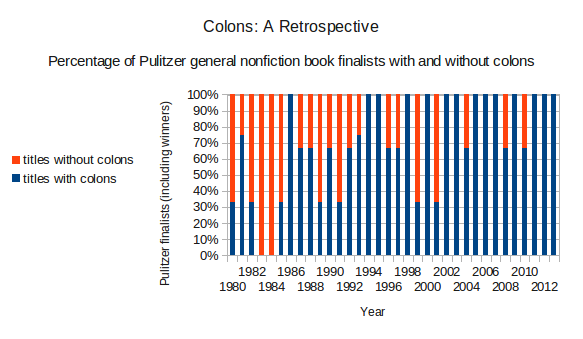Blog by Sumana Harihareswara, Changeset founder
Colons: A Retrospective
Hi, reader. I wrote this in 2013 and it's now more than five years old. So it may be very out of date; the world, and I, have changed a lot since I wrote it! I'm keeping this up for historical archive purposes, but the me of today may 100% disagree with what I said then. I rarely edit posts after publishing them, but if I do, I usually leave a note in italics to mark the edit and the reason. If this post is particularly offensive or breaches someone's privacy, please contact me.
I am working on another silly project, and it led me to look at winners and finalists for the Pulitzer Prize for General Nonfiction. There are way more colons in the titles of those books than there used to be.
At Leonard's suggestion, I did a stacked graph via LibreOffice.

Here's the original data, and here's the breakdown by year. I went from 1980 to the present because 1980 is the first year the Pulitzer folks released the list of finalists.
I know many people will not find it surprising that we've got a whole lot of colons these days. But look at the old titles: there used to be so few! 1963: Barbara W. Tuchman's The Guns of August. 1975: Annie Dillard's Pilgrim at Tinker Creek. I may ask some publishing-y people what forces and trends change book titles over time, and whether Pulitzer finalists are outliers when it comes to book-naming. Three or four titles per year makes for a ridiculously tiny sample size.
Comments
valhallasw
30 Nov 2013, 14:53 p.m.

Really cool! I thought I could use this as a nice example of how to do data analysis with Python -- see http://nbviewer.ipython.org/gist/valhallasw/7723637 for my version. It also takes a look at the length of the titles, which seems to increase somewhat in time (of course, you need longer titles if you have colons!) and there is some cylical motion.